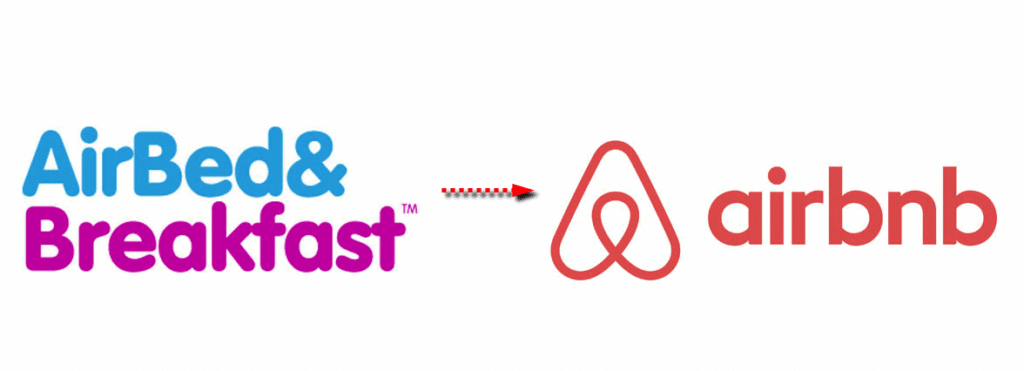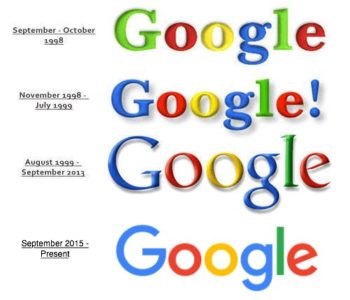So, you’ve come to the point where you’re Googling “How to Rebrand?” and “When to Rebrand?”
Both are valid searches, and both may seem a little daunting. But the fact is, the rebrand is a fantastic tool that many massive firms have executed beautifully.
Have you seen the logo for Airbnb from back in the days of neon-colored skinny jeans and peak Lindsay Lohan?

What about Google’s journey from the quirky ’90s search engine to its sleek metamorph?

Point is, rebranding works.
However, you don’t need to be a corporate monolith to have a fantastic and effective rebrand. You just need to follow some best practices and stay in tune with your company’s vision and values. (We talk more specifically about how to rebrand here.)
Wondering how to know it’s time? Let’s dive in.
TLDR; Contents
What is Rebranding?
So, let’s start from the beginning.
There’s your brand, which is how your company presents itself to the public and differentiates itself in the market. Your brand can impact not only the way your audience sees you but also how much they value your product—and are willing to pay for it.
And it’s the sum of all of the experiences prospective and current customers have with your organization. A good brand effectively tells the public your value proposition, establishes credibility and trust, and targets the right audience.
Your brand is based on your brand identity—the visual elements that encompass the look and feel of your organization. It spans everything from your logo and name to brand voice, tagline, visual identity, and your website and marketing materials.
And finally, there’s rebranding: the process of re-honing and re-constructing your brand and brand identity—how your company is externally perceived.
Why Rebrand?
Well, there are several reasons why you’d want to rebrand—but they’re all associated with creating a stronger brand.
Stronger brands are more likely to be chosen over competitors and attract more customers with higher willingness-to-pay but at lower CAC (customer acquisition costs.) And stronger brands foster more customer loyalty, which fuels more efficient and reliable revenue.
Moreover, stronger brands also help companies attract and retain top talent.
But the gist is—rebranding is an excellent tool to keep up with market forces, the zeitgeist, and changing industry design trends.
To have that “Cool Factor” and not be “cheugy,” as the youths say.
When to Rebrand
Several telling indicators tell you when it’s time to rebrand. Here are a few:
Your business is changing.
If your company’s business is changing, you’ll want to continuously and clearly communicate to your audience what is happening and where it’s going.
For instance, say you’re a magician social networking app venturing into the culinary space. This addition may seem disjointed or irrelevant to your audience, or they may not trust you know what you’re doing. But you have a strategy, and you know it makes sense for your business.
Therefore, this is where clear brand communication comes in. One that affirms that yes, you do know what you’re doing, culinarily. That you are doing this for reasons that make sense. And lastly, that you have built something worth your customers’ time and money.
So, if you’re adding a new product that is a significant shift from your previous direction, and your value proposition changes, you’ll want to let new and current customers be able to detect that so that they trust and come to you.
Several business changes are relevant here:
- Entering new markets: new market → different demographics and a new audience, and depending on geography, a new culture. The perfect opportunity to rebrand into something more ~luxurious~ or casual and harness a new market position.
- Adding new revenue streams or products: when you’re venturing into a new space, it’s critical to communicate why you’re doing that—and make your brand cohesively encompass all that your company offers.
- Mergers or acquisitions: if you’re merging with or acquiring a new company, it’s similar to adding a new product—you’ll want your branding to explain why you did so in a way that’s cohesive to all of your products and evokes trust in your audience.
Your target demographic has changed,
or your branding is no longer “with the times.”
If you’re noticing a shift in your target demographic, it may be time to readjust your messaging and how you target your audience.
For instance, as Gen Z is entering the finance and housing markets, it’s essential to grow and adapt to brand strategies that fit them. And, while it’s important to differentiate, it’s also necessary to walk the fine line between standing out and innovating without being too out there.
Ergo, it’s a delicate dance between following current design trends and best practices while differentiating and creating a unique customer experience. So be cute—but not too cute.
So, 81% of proud Gen Z members indicated that Instagram and Youtube are their preferred social networks. Therefore, it may be time to rebrand with strategies in tune with mobile friendliness.
Additionally, consider short-form video content, interactive content, humor, and responding to online customer engagement with an on-brand voice. Something “fun” and “cool”—as vague as that may sound (we get to brand voice guidelines in our How to Rebrand post.)
Your brand needs some differentiation.
As we mentioned before, there’s a fine line between differentiating your brand and still following identifiable, familiar, and relatable best practices.
This is where competitive analysis will play a huge role in your rebranding efforts. In your rebranding, you’re going to want to incorporate current design trends that signal to your audience that you belong in the space you are in (or are entering)—while retaining an original take on prevailing design trends.
So, you’ll want to shift from generic logos and stock art. Instead, incorporate coloring, typography, visual elements, and a brand voice that’s relatable to your audience based on your target market analysis.
With those, you’ll want to showcase the things that differentiate your company and value proposition from your competitors. Additionally, you’ll want to invest in market testing before launching your rebrand.
You’re having a tough time with re-pricing (specifically, upwards.)
If you’re having a tough time raising your prices, it may be time to adopt branding and rebrand into a more ~luxe~ feel. So, how do we define a more “expensive-looking” branding strategy?
By conveying your value proposition in a highly refined way that feels legitimate and current.
That means an expertly designed and cohesive brand identity. A beautifully crafted brand will have a catchy, original, and instantly informative name and logo.
Additionally, your online platforms should be professional, consistent, and incorporate visual elements that are communicative, sleek, and responsive—whether they’re static or interactive.
You should incorporate customer testimonials and put your exceedingly fantastic customer experience at the forefront. So, that includes everything from the UX/UI design of your platforms and product to customer service.
And, you should put your brand on everything—your product itself, your websites, and your marketing collateral—because you’re proud of your brand, and everyone should know it.
Lastly—and most importantly—it’s critical that your rebrand is market-tested thoroughly. You need to ensure that your audience resonates with your new branding and its new pricing. Basically, the two need to make sense to a broad audience and make the new pricing sensible to the public—not just your internal team.
Therefore, by marketing your brand to have a more legitimate and modern way, you’ll be able to tell your audience: “Hey. We’re cool. We know what we’re doing. We’re the best in the field. And that’s we deserve a pay bump.”
You’re trying to recover from a reputational mishap.
Alright. So, there was a misstep somewhere in there.
Whether it was lacking customer service, a bug, or a leak—things happen. And rebrandings often follow those missteps because companies need to disassociate their past from their sparkling futures.
To elaborate, I’m not just talking about “Meta” magnitude reputational downfalls. When your reputation needs a refresh, that’s precisely the time to use a rebrand.
It’s essential to keep it at least partially reminiscent of your old brand so that it’s not an utterly jarring flip from the past (which could confuse current users or customers.)
However, this is your chance to reimagine what your company stands for, your vision, and how you’ll communicate your rightfully impeccable future reputation to the public.
So, get out those 75 million colored dry-erase markers. Get original, market-test your rebranding ideas, and take a hard look at your brand voice and brand guidelines.
What do you want to tell your users? That your customer service department got an overhaul? That your security and privacy infrastructure is now the top in the industry (looking at you, Apple?)
Finally, think (but also know, through robust and data-driven primary research and validation), what is the best way to make your audience trust you again. What are the subtle yet powerful UX/UI and branding devices you’ll use to change their minds?
Because we know you’ve changed for the better.
You just have to let everyone else know that.
You’re struggling with recruiting (top talent.)
If you’re struggling with recruiting top-tier talent or talent that’s the right culture fit for your company, it might be time to rethink how you’re presenting yourself.
As Millenials and Gen Z increasingly make up the workforce, the “Cool Factor” of company brands is dominating attracting employees. A strong brand is key to the cool factor (as discussed above.) Additionally, employees are attracted to companies where they can feel recognized and make a difference.
So then, there’s honing your Employer Branding.
At first, you should start by understanding your employer standing. Who are the people applying to your open positions? What are their priorities in choosing you, and how do they evaluate your company as opposed to others?
Employer reviewers are vital—so check out your Glassdoor or Ziprecruiter ratings to see where you succeed and where you should improve. Respond to reviews to show you care in your most professional and engaged brand voice—and take feedback seriously.
And, from there, identify your candidate personas, and tailor your core values and mission statement to them in a way that still rings true with your company vision. Moreover, learn what competitors are doing to appeal to their people and enhance your internal employer brand accordingly.
Everyone likes a free catered lunch here or there, but that’s not what will make the final decision for someone receiving an offer.
So, be known for valuing your employees. For instance, set up public content calendars with employee spotlights that show you recognize your people’s hard work.
Additionally, make sure your benefits are meeting and even exceeding industry standards—especially healthcare and 401k contributions—and make it known.
And finally, maybe throw in a catered lunch or two—because while those won’t make a prospective employee’s decision, everyone likes a free artisinal burrito bar.
Well, this was a lot. We know.
So, it could be beneficial to consult product strategy and design experts who’ll help you put the theory to the rubber.
Coincidentally, hi, we’re Goji Labs—a product and software development consultancy with experience in designing, “rescuing,” and deploying hundreds of products.
Looking to develop a new app or revamp an existing one?
Have any general questions about who we are and our authority on the subject?
Reach us at GojiLabs.com.
– Goji Labs




